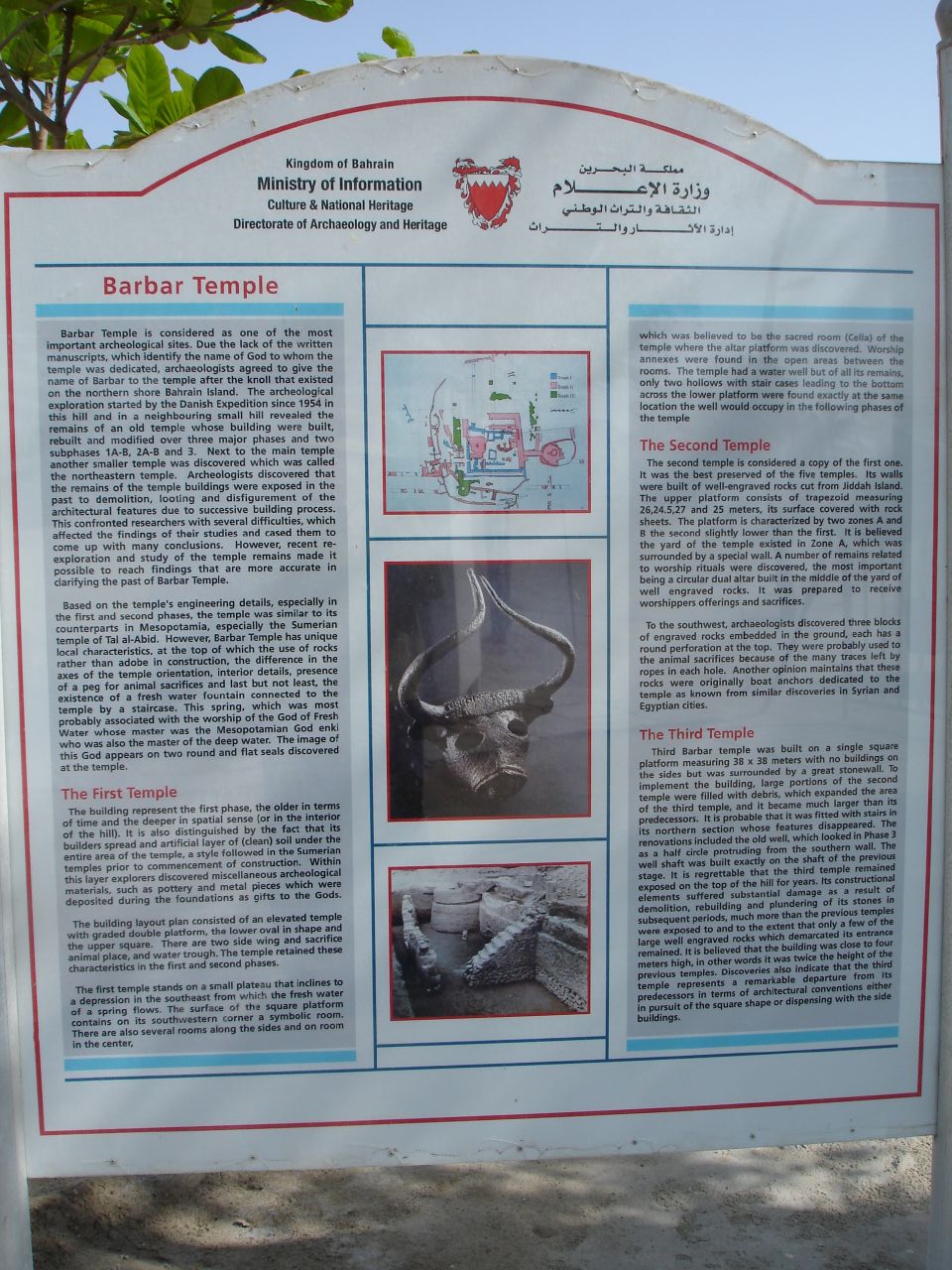Barbar temple on:
[Wikipedia]
[Google]
[Amazon]
The Barbar Temple is an
 The three temples were built atop one another with the second built approximately 500 years later and the third added between 2100 BC and 2000 BC.
It is thought that the temples were constructed to worship the god ''
The three temples were built atop one another with the second built approximately 500 years later and the third added between 2100 BC and 2000 BC.
It is thought that the temples were constructed to worship the god ''
archaeological site
An archaeological site is a place (or group of physical sites) in which evidence of past activity is preserved (either prehistoric or historic or contemporary), and which has been, or may be, investigated using the discipline of archaeology an ...
located in the village of Barbar, Bahrain
Bahrain ( ; ; ar, البحرين, al-Bahrayn, locally ), officially the Kingdom of Bahrain, ' is an island country in Western Asia. It is situated on the Persian Gulf, and comprises a small archipelago made up of 50 natural islands and an ...
, considered to be part of the Dilmun
Dilmun, or Telmun, ( Sumerian: , later 𒉌𒌇(𒆠), ni.tukki = DILMUNki; ar, دلمون) was an ancient East Semitic-speaking civilization in Eastern Arabia mentioned from the 3rd millennium BC onwards.
Based on contextual evidence, it was l ...
culture. The most recent of the three Barbar temples was rediscovered by a Danish
Danish may refer to:
* Something of, from, or related to the country of Denmark
People
* A national or citizen of Denmark, also called a "Dane," see Demographics of Denmark
* Culture of Denmark
* Danish people or Danes, people with a Danish a ...
archaeological team in 1954. A further two temples were discovered on the site with the oldest dating back to 3000 BC. The temples were built of limestone
Limestone ( calcium carbonate ) is a type of carbonate sedimentary rock which is the main source of the material lime. It is composed mostly of the minerals calcite and aragonite, which are different crystal forms of . Limestone forms whe ...
blocks, believed to have been carved out from Jidda Island
Jidda Islands ( ar, جزيرة جدة) are a group of three small uninhabited islets in Bahrain, lying to the west of Bahrain Island and just north of Umm an Nasan in the Persian Gulf. They are west of the capital, Manama, on Bahrain Island.
His ...
.
History
 The three temples were built atop one another with the second built approximately 500 years later and the third added between 2100 BC and 2000 BC.
It is thought that the temples were constructed to worship the god ''
The three temples were built atop one another with the second built approximately 500 years later and the third added between 2100 BC and 2000 BC.
It is thought that the temples were constructed to worship the god ''Enki
, image = Enki(Ea).jpg
, caption = Detail of Enki from the Adda Seal, an ancient Akkadian cylinder seal dating to circa 2300 BC
, deity_of = God of creation, intelligence, crafts, water, seawater, lakewater, fertility, semen, magic, mischief
...
'', the god of wisdom and freshwater, and his wife ''Nankhur Sak'' (Ninhursag
, deity_of=Mother goddess, goddess of fertility, mountains, and rulers
, image= Mesopotamian - Cylinder Seal - Walters 42564 - Impression.jpg
, caption=Akkadian cylinder seal impression depicting a vegetation goddess, possibly Ninhursag, sitting ...
). The temple contains two altars and a natural water spring that is thought to have held spiritual significance for the worshipers. During the excavation of the site many tools, weapons, pottery and small pieces of gold were found which are now on display in the Bahrain National Museum
The Bahrain National Museum ( ar, متحف البحرين الوطني) is the largest and oldest public museum in Bahrain. It is situated in Manama, adjacent to the National Theatre of Bahrain. Opened on 15 December 1988 by the Emir of Bahrain ...
. The most famous find was a copper bull's head.
The site is on the tentative
{{Short pages monitor